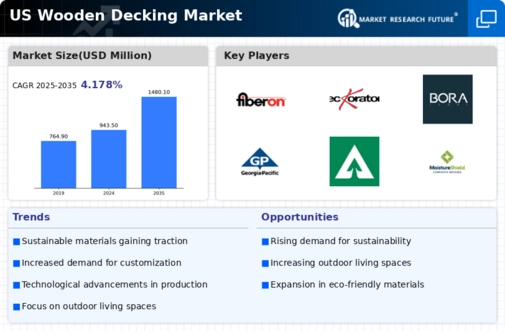The wooden decking market in the US is characterized by a competitive landscape that is increasingly shaped by innovation, sustainability, and strategic partnerships. Key players such as Trex Company (US), Fiberon (US), and TimberTech (US) are at the forefront, each adopting distinct strategies to enhance their market positioning. Trex Company (US) focuses on eco-friendly products, leveraging recycled materials to appeal to environmentally conscious consumers. Meanwhile, Fiberon (US) emphasizes product diversification and regional expansion, aiming to capture a broader customer base. TimberTech (US) is noted for its commitment to technological advancements in decking solutions, which enhances durability and aesthetic appeal. Collectively, these strategies contribute to a dynamic competitive environment, where differentiation is increasingly based on innovation and sustainability rather than solely on price.
In terms of business tactics, companies are localizing manufacturing and optimizing supply chains to enhance efficiency and responsiveness to market demands. The market structure appears moderately fragmented, with several players vying for market share, yet the influence of major companies remains substantial. This competitive structure allows for a variety of offerings, catering to diverse consumer preferences while fostering innovation across the sector.
In October 2025, Trex Company (US) announced a new line of composite decking products that utilize 95% recycled materials, reinforcing its commitment to sustainability. This strategic move not only aligns with growing consumer demand for eco-friendly options but also positions Trex as a leader in sustainable practices within the industry. The introduction of this product line is likely to enhance brand loyalty and attract environmentally conscious consumers, thereby strengthening Trex's market position.
In September 2025, Fiberon (US) expanded its distribution network by partnering with several regional suppliers, aiming to improve product availability and customer service. This strategic partnership is significant as it allows Fiberon to penetrate new markets more effectively, ensuring that its products are accessible to a wider audience. Such moves are indicative of a broader trend towards localized supply chains, which can enhance responsiveness to regional market dynamics.
In August 2025, TimberTech (US) launched an innovative digital platform that integrates augmented reality (AR) technology, allowing customers to visualize decking options in their own outdoor spaces. This initiative not only enhances the customer experience but also reflects a growing trend towards digital transformation in the industry. By leveraging technology, TimberTech is likely to differentiate itself from competitors, appealing to tech-savvy consumers who value interactive shopping experiences.
As of November 2025, the competitive trends in the wooden decking market are increasingly defined by digitalization, sustainability, and technological integration. Strategic alliances are becoming more prevalent, enabling companies to enhance their product offerings and market reach. Looking ahead, it appears that competitive differentiation will evolve, with a shift from price-based competition to a focus on innovation, technology, and supply chain reliability. Companies that can effectively integrate these elements into their strategies are likely to thrive in this dynamic market.






















Leave a Comment